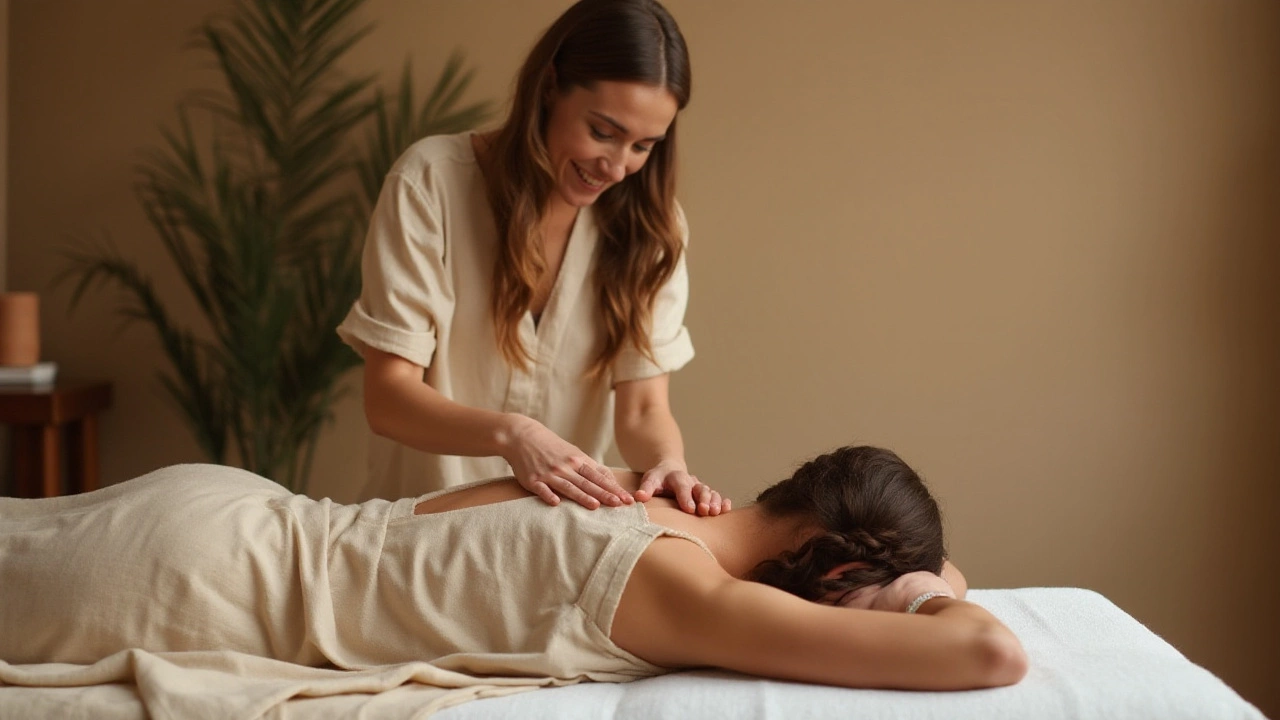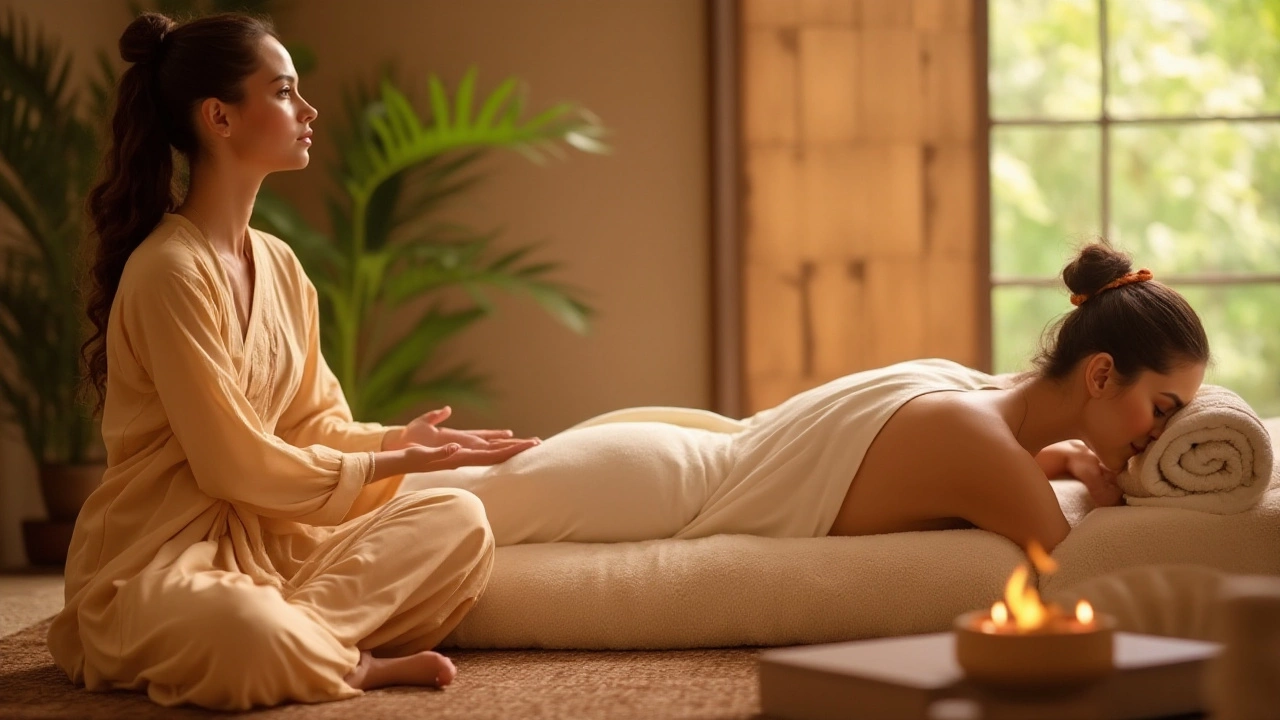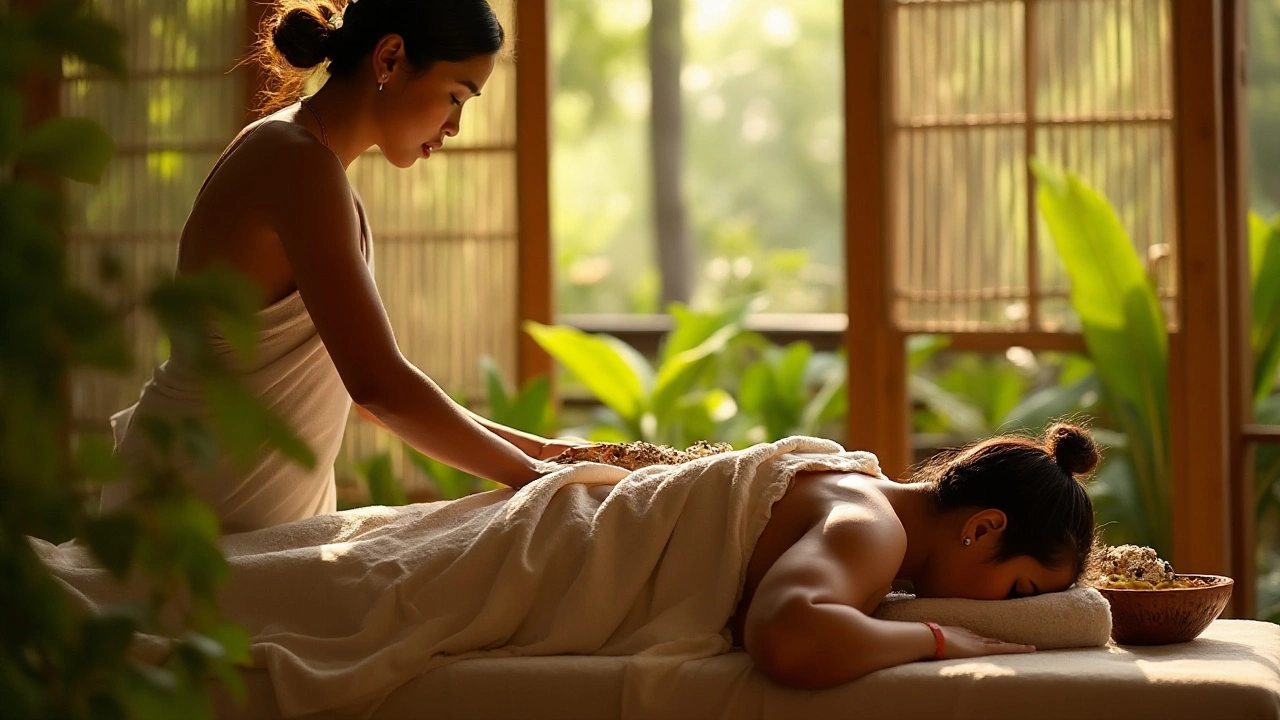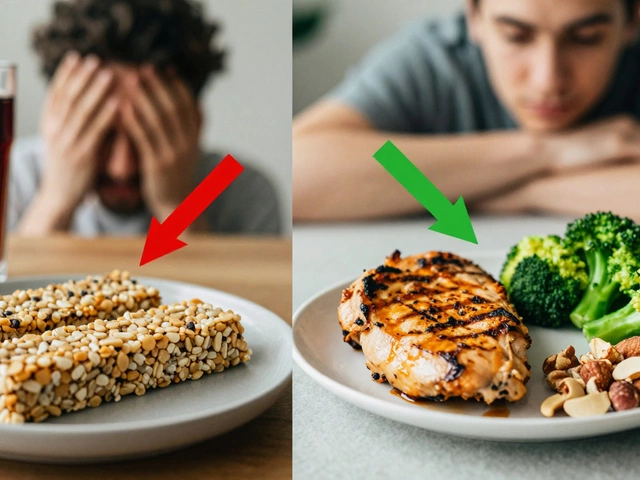Embarking on the journey of Ayurvedic therapy is stepping into a world where ancient wisdom meets personal well-being. One important aspect of this holistic experience is choosing what to wear. The right attire not only contributes to your comfort but also enhances the therapeutic effects of the session.
Traditional Ayurvedic massages often embrace simplicity and comfort. You might find yourself in a lightweight garment, often provided by the spa, made from breathable materials that facilitate ease of movement. These garments are designed to accommodate the generous application of herbal oils that are pivotal in Ayurvedic treatments.
While some prefer to stick to the conventional clothing offered at Ayurvedic centers, others may opt for contemporary adaptations that align with personal preferences. Ultimately, the goal is to create an environment where you feel relaxed and at ease, allowing the massage to work its magic effectively.
- Understanding Ayurvedic Massage
- Traditional Attire Choices
- Modern Adaptations
- Cultural Influences on Clothing
- Personal Comfort and Hygiene
- Tips for First-Time Visitors
Understanding Ayurvedic Massage
Ayurvedic massage, known as Abhyanga in its traditional practice, is more than just a form of relaxation. It is a critical component of Ayurveda, the ancient system of medicine from India that focuses on balance and harmony within the body. This full-body massage incorporates warm herbal oils, which are carefully selected based on each individual's dosha—or bodily constitution—comprising Vata, Pitta, and Kapha. Each dosha represents a combination of elements and energies designed to bring balance to the mind and body. During the massage, the therapist skillfully applies the oil, often in generous amounts, using continuous strokes that are meant to stimulate blood circulation, remove toxins, and enhance the body's natural healing abilities.
The healing nature of Abhyanga lies not only in the physical benefits but also in mental and emotional rejuvenation. It's said that this technique can calm the nerves, reduce stress, promote better sleep, and even slow down the aging process. The regular practice of Ayurvedic massage is believed to enhance overall vitality and well-being, aligning the mind, body, and spirit. While the principles of Ayurvedic massages remain consistent, each session is unique to the individual receiving it, customized to their body's specific needs at that moment. This is reflective of Ayurveda's broader philosophy, which views health as a personalized state of well-being.
An interesting aspect of Ayurvedic massage is its emphasis on the use of natural oils, which are often infused with medicinal herbs. The choice of oil is significant; sesame oil is commonly used due to its warming properties, while coconut oil might be chosen for its cooling effect. Each oil is meant to nourish the skin, enabling the detoxification process through the pores. Harish Johari, a renowned scholar of Ayurvedic medicine, once expressed,
'The practice of Abhyanga is not just a superficial experience; it is an act of self-love and respect, a way of deeply caring for one's own body.'As the massage proceeds, the therapist might apply varying pressures, helping to remove knots and tension. The combination of oil application and rhythmic strokes energizes and invigorates the body, leading to a deeply restorative experience.
The therapy can also involve the use of specific marma points—vital points in the body considered gateways to energy. By stimulating these points, an Ayurvedic massage can release both physical and emotional blockages, facilitating the flow of prana, or life force, throughout the body. This invites a profound sense of relaxation and inner peace, which some describe as achieving a meditative state of being. The holistic approach of Ayurvedic massage underscores its therapeutic benefits, which transcend beyond mere physical touch and delve into the realms of spiritual healing and emotional balance, making it a treasured practice for those seeking comprehensive health and harmony.
Traditional Attire Choices
When stepping into an Ayurvedic haven, you are enveloped in practices that are steeped in centuries of tradition. The choice of attire in such settings is deliberately simplistic, resonating with the understated elegance of the ancient science. Traditionally, recipients of an Ayurvedic massage wear garments that are minimally invasive—often no more than a thin cloth or cotton garment provided by the spa. This attire is designed to allow the therapist unimpeded access to the body’s key pressure points and marma points. The materials are light and breathable, ensuring that the skin is receptive to the therapeutic oils used throughout the session.
This traditional approach emphasizes the importance of the therapist's access to the body, enhancing the flow of energy and healing processes. The attire often includes a cotton dhoti or a simple cloth wrap, both aimed at maintaining dignity and ease. These garments are purposefully crafted to accommodate oil absorption and ease of movement, allowing the body to luxuriate in the laden oils without hindrance. A well-chosen garment enhances the massage experience by keeping the recipient relaxed, which is paramount for the efficacy of the therapy.
These conventional dress codes may seem archaic, but they hold profound significance in maintaining the authenticity of Ayurvedic rituals. Dr. Vasant Lad, a well-regarded Ayurveda expert, once stated,
"The attire in Ayurveda is not merely a formality; it is a vessel of the massage's intention, allowing the body to be free and open, just as the mind should be during these transformative therapies."This statement underlines the intrinsic value that traditional attire brings to the table, seamlessly blending functionality with the profound depths of ancient wisdom.
Despite the adherence to age-old traditions, many Ayurvedic centers have adapted to accommodate varying comfort levels, offering alternatives that retain traditional values while introducing a touch of personal preference. However, the heart of the practice remains unchanged—the clothing is secondary to the experience, serving as merely a vehicle to help navigate the therapeutic journey. In understanding and appreciating these traditional attire choices, one truly steps into the holistic world that Ayurveda offers, where every element is designed with purpose and precision.

Modern Adaptations
In today's fast-paced world, the practice of Ayurvedic massage has been embraced and adapted to fit modern lifestyles and preferences. This ancient art of healing, traditionally imbued with rituals dating back thousands of years, is now experiencing a renaissance as people seek natural therapies to counterbalance contemporary stressors. As such, the attire worn during these massages has also evolved, marrying tradition with practicality and style.
Conventionally, Ayurvedic massages would see participants dressed in minimal, loose-fitting garments, often provided by the spa or wellness center. These were typically made from natural fibers such as cotton to ensure comfort and breathability. However, with the increase in popularity of Ayurvedic practices worldwide, especially in urban areas, there has been a noticeable shift in cultural expectations about the treatment environment. People today value a personalized experience, which extends to their choice of clothing. Ayurvedic massage centers now cater to these preferences by allowing clients to wear their own light and adaptable attire. This trend doesn't just promote individuality but also allows clients to maintain a sense of privacy, which is especially appreciated by those new to the therapy.
Many individuals choose to wear yoga outfits or sportswear that they find flexible and non-restrictive. The emphasis is on clothing that permits full range of motion while still accommodating the therapeutic application of oils. Unlike traditional materials, modern synthetic blends offer quick-drying properties which many find advantageous, especially in the setting of an oil-rich treatment. Moreover, today's clothing options often include innovative fabric technologies designed to wick away moisture, keeping the skin dry and comfortable.
Interestingly, some spas integrate this modern adaptability into their services by offering tailored clothing options that match the aesthetics of the spa experience, including robes or sarongs in contemporary styles. This incorporation of modern attire aligns with a broader trend seen across global wellness practices: the personalization of health experiences. Choosing what to wear has become an extension of identity, an expression of how one approaches health and relaxation. Renowned wellness author Deepak Chopra notes,
"The way we approach our health rituals, including attire, is a reflection of how we honor our personal well-being."
These modern adaptations are not just about comfort, but also hygiene. Ayurvedic treatments involve significant use of herbal oils, and for many, wearing personal garments reduces concerns about hygiene and post-massage cleanliness. Simple, dark-colored garments can help avoid noticeable stains from oils, and thanks to advancements in detergent formulations, cleaning them has become easier than ever. Incorporating these modern preferences into the experience helps ensure that everyone can enjoy an Ayurvedic massage with little worry, which is the ultimate goal—relaxation and rejuvenation.
Therefore, while tradition and authenticity remain core components of Ayurvedic therapy, these modern adaptations signify a broader acceptance and assimilation of cultural practices into the global mainstream. Whether someone opts for traditional or modern attire, the essence of Ayurvedic massage remains unchanged: a holistic approach to restoring balance and fostering a deep, lasting sense of well-being.
Cultural Influences on Clothing
The landscape of clothing within Ayurvedic massages is richly diverse, deeply woven with threads of culture, tradition, and modern adaptation. Ayuverda, being an ancient practice with roots in India, profoundly reflects the sartorial customs of the region. Traditional practices often dictate that massage participants should be clothed in garments made from natural fabrics such as cotton or linen. These materials are widely favored not only for their breathability but also for their cultural significance as symbols of purity and simplicity.
In many Ayurvedic centers around the world, especially those maintaining strong ties with Indian traditions, participants may be offered a dhoti or a saree-like wrap. These garments are emblematic of Indian heritage, draped in a way that facilitates the absorption of herbal oils used during the massage. The garments often come in a neutral palette, enhancing their calming effect on the recipient. The materials allow flexibility, which is crucial in ensuring that the body can move naturally during the session, allowing the energy pathways, or nadis, to open fully, optimizing the healing effect.
As Ayurvedic practices spread globally, they encounter diverse cultural landscapes, each bringing its unique perspective on what constitutes appropriate attire. In Western contexts, for instance, the emphasis has shifted towards convenience and comfort. Clients often wear loose, lightweight clothing akin to yoga wear, which aligns well with modern perceptions of wellness and self-care.
"Ayurveda has beautifully transcended geographical boundaries, allowing a fusion of cultural insights into what people find comfortable and practical," notes Dr. Vasant Lad, a renowned Ayurvedic physician.
This melding of cultures is evident in how each region adapts the traditional principles of Ayurvedic massages to fit local norms. In Middle Eastern countries, modesty is paramount, and adaptations are made to ensure privacy and comfort, often with additional fabric wraps to overlay the basic massage attire. Meanwhile, in the Nordic regions, the attire may also be influenced by the climate, with spas opting for thicker, warmer materials that still honor the traditional elements of Ayurvedic practices.
This dual influence of tradition and modern comfort allows practitioners and clients alike to respect and honor the rich heritage of Ayurveda while also considering the practicality of local norms. This integration is not just about clothing but extends to the essence of Ayurveda's adaptability and its commitment to individual wellness. Ayurvedic massage centers are mindful of these cultural nuances and often provide tailored advice to first-time clients to ensure an authentic yet comfortable experience.

Personal Comfort and Hygiene
When it comes to Ayurvedic massage, personal comfort and hygiene are paramount. The ancient wisdom encapsulated in Ayurveda emphasizes balance and harmony, extending beyond the treatment itself to your preparation beforehand. To ensure the best experience, wearing clothing that allows you to relax is critical. Choose garments that do not cling to the body, allowing the skin to breathe, especially since these massages often involve generous use of herbal oils. Such oils are integral to the process, believed to detoxify, nourish, and revitalize the body's system.
Before stepping into the tranquil environment of an Ayurvedic spa, it might be beneficial to familiarize oneself with the spa's amenities. Many establishments provide disposable undergarments to maintain hygiene standards. This provision allows for a seamless blend of traditional practices and modern comfort. Skilled massage therapists often advise taking a shower prior to the massage to cleanse the skin, which helps the herbal oils penetrate deeper into the skin layers. This practice is rooted in the belief that clean skin is more receptive to the healing effects of the therapy.
"Cleanliness is central to all things related to healing," shares Dr. Ananda, a respected Ayurvedic practitioner. "It’s not just about external hygiene. Clean skin supports the restorative processes within."
Besides ensuring cleanliness, personal comfort enhances mental relaxation too. Feeling at ease physically allows your mind to unwind, aligning perfectly with the holistic nature of Ayurvedic therapy. Loose-fitting clothes, like a sarong or a cotton wrap, are often advised as they respect traditional practices while catering to modern preferences. This thoughtful blend promotes the flow of energy, a crucial component in Ayurvedic healing.
Besides, paying attention to other aspects of hygiene like well-groomed hair, trimmed nails, and minimal use of perfumes or deodorants contributes to the massage efficacy. Overuse of synthetic products may interfere with the herb-infused oils. Therapists highlight that a mild, natural scent of the body oils like sesame or coconut should prevail, creating an atmosphere where nature comfortably whispers its magic.
Tips for First-Time Visitors
Entering the gentle world of Ayurvedic massage can be a little daunting for newcomers. The ancient practice, rich with tradition, offers a serene escape from the everyday hustle, but preparation can enhance your experience. For starters, it’s vital to understand that Ayurvedic therapies thrive on the principle of balance and harmony. Therefore, attire plays a significant role in maintaining this equilibrium. Choose clothes made from natural fibers, such as cotton, which allow your skin to breathe, aligning with the holistic nature of Ayurveda. Cotton's absorbent qualities ensure that the herbal oils used during the massage are effectively absorbed, enhancing their therapeutic benefits.
Arriving with a clear mind can significantly impact your session. It's beneficial to engage in light meditation or breathing exercises before your appointment. This aligns your body and mind with the relaxing atmosphere of the massage, allowing you to be fully present. It's said that the mind is the hardest muscle to relax, so starting early can make all the difference. Consider arriving a few minutes before your scheduled time—rushing can lead to unnecessary stress, counteractive to the massage's purpose.
Hydration before and after your Ayurvedic massage is crucial. Before the massage, a well-hydrated body prepares your skin for better absorption of oils, magnifying their effects. Post-massage, drinking water helps flush out toxins released during the therapy. It's often recommended to avoid heavy meals pre-massage; a light snack will suffice. This helps your body direct its energy toward relaxation and healing, rather than digestion. Remember, the experience is meant to bring peace and rejuvenation. Hence, comfort at every level is key.
Communication with your therapist is equally important. Don’t hesitate to disclose any particular discomfort or sensitivities you might have. They are trained to tailor the massage to your needs, ensuring a personalized and effective session. The goal is to create a safe and nurturing environment where healing thrives. If you're unsure about something, ask. Your therapist is a knowledgeable ally in your journey.
"Ayurveda is not just a system of medicine in the conventional sense of curing disease. It is a Science of Life," says Deepak Chopra, a well-known advocate of Ayurvedic health practices.
If you’re a person who enjoys structure, knowing the flow of an Ayurvedic massage can be comforting. Typically, the massage begins with head and neck treatment, moving towards the extremities in a rhythm that mimics the natural energy flows of the body. Understanding these movements help even the most anxious individuals to relax, as they align their expectations with the process.
Maintaining realistic expectations can greatly enhance your first encounter with Ayurvedic massage. Understand that wellness is a journey, not a destination. Healing in Ayurveda is gradual and holistic, often requiring ongoing application rather than immediate results. Embracing this mindset not only enriches your massage experience but enhances your overall approach to health. So, cherish this first step into a world where ancient practices meet personal renewal.





